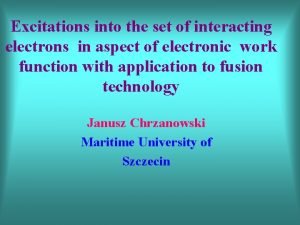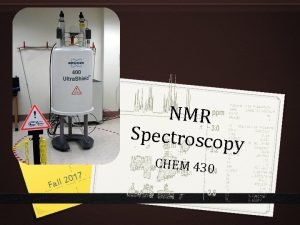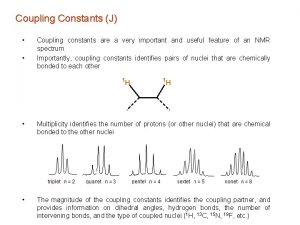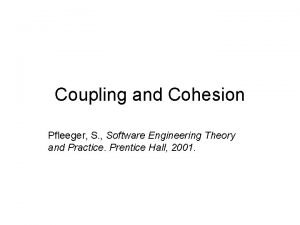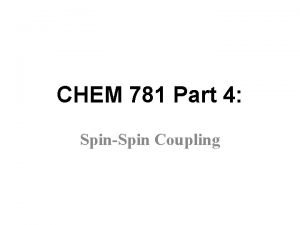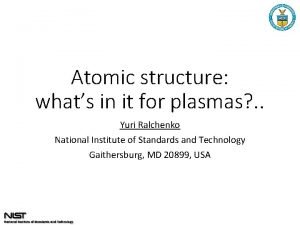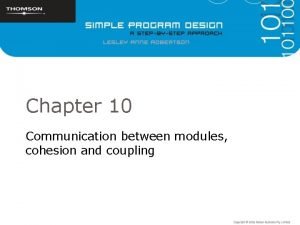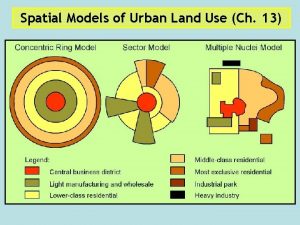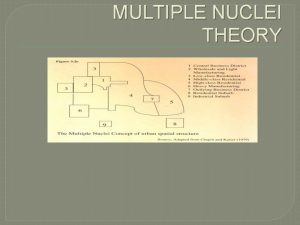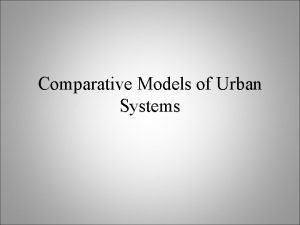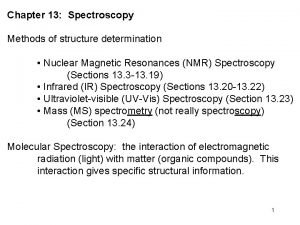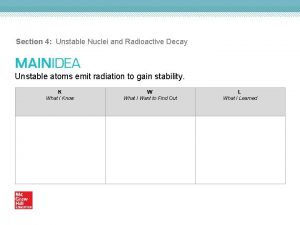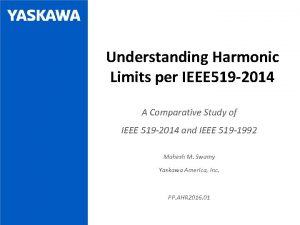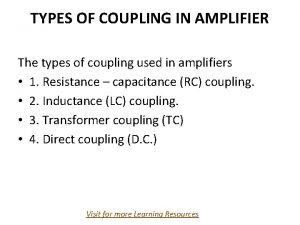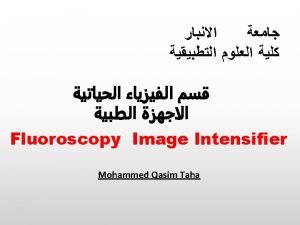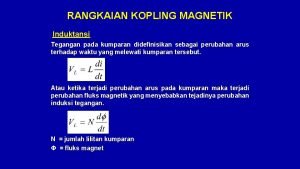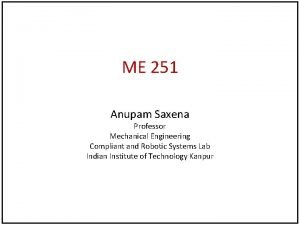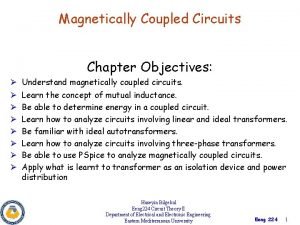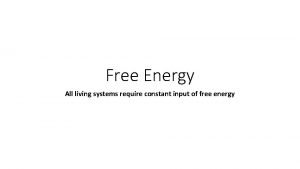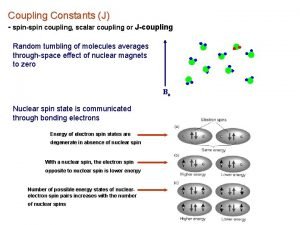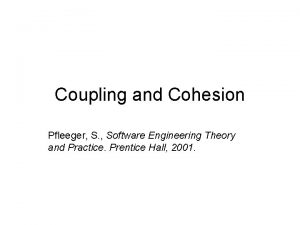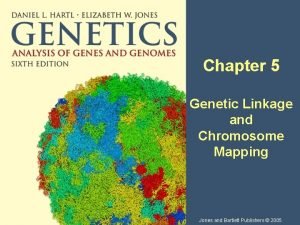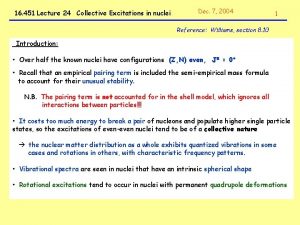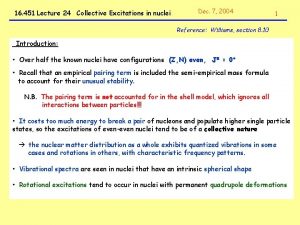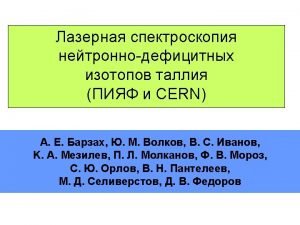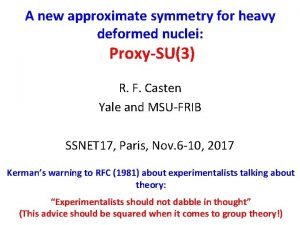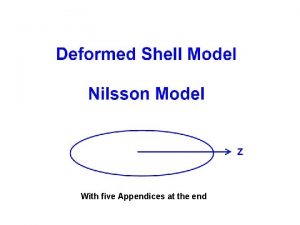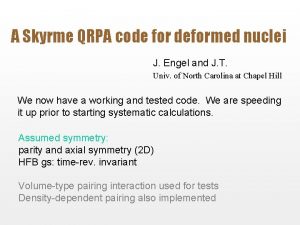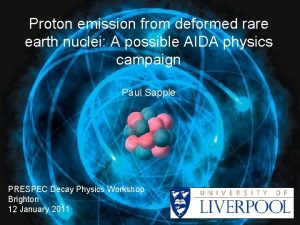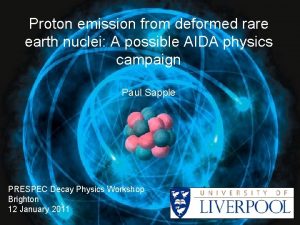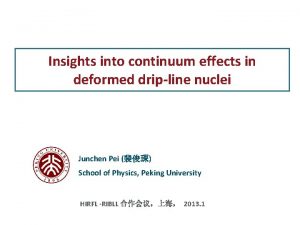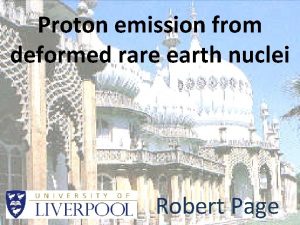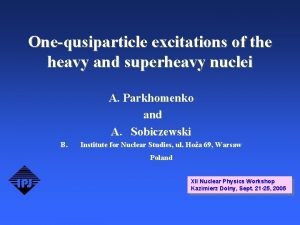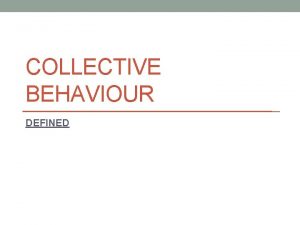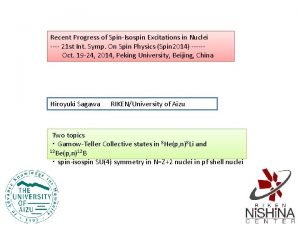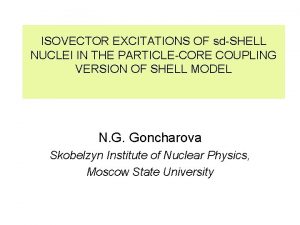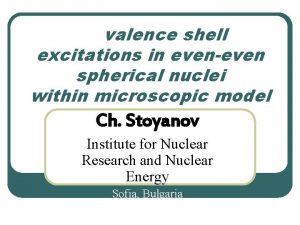Collective Excitations of Deformed Nuclei and their Coupling







![Single-Particle A=155 Quadrupole Moments in a deformed W-S potential [505]11/2 Low Density of Oblate Single-Particle A=155 Quadrupole Moments in a deformed W-S potential [505]11/2 Low Density of Oblate](https://slidetodoc.com/presentation_image_h2/e8ffd77032a266e76a0d52bf1f6fff72/image-8.jpg)
![Configuration Dependent or Quadrupole Pairing; Assume Δpp≈ Δoo>> Δop Nilsson Diagram N~90 [505]11/2“Oblate” [521]3/2[660]1/2+ Configuration Dependent or Quadrupole Pairing; Assume Δpp≈ Δoo>> Δop Nilsson Diagram N~90 [505]11/2“Oblate” [521]3/2[660]1/2+](https://slidetodoc.com/presentation_image_h2/e8ffd77032a266e76a0d52bf1f6fff72/image-9.jpg)


![Kπ=15/2=2γ+ + [505]11/2 - 155 Gd 91 High-K Decay Scheme Missing │02+ > coupling Kπ=15/2=2γ+ + [505]11/2 - 155 Gd 91 High-K Decay Scheme Missing │02+ > coupling](https://slidetodoc.com/presentation_image_h2/e8ffd77032a266e76a0d52bf1f6fff72/image-12.jpg)




![The way the Soloviev qp-phonon model (QPM) works is as follows; 1] He postulates The way the Soloviev qp-phonon model (QPM) works is as follows; 1] He postulates](https://slidetodoc.com/presentation_image_h2/e8ffd77032a266e76a0d52bf1f6fff72/image-17.jpg)
















- Slides: 33

Collective Excitations of Deformed Nuclei and their Coupling to Single Particle States J. F. Sharpey-Schafer Physics Department, University of Western Cape, Belleville, South Africa.

Bohr & Mottelson Vol II Page 363 !!

Nikšić et al. Li et al. PR C 79(2009) 054301 PRL 99 (2007) 092502 Self-consistent Relativistic Mean Field +BCS


154 64 Gd 90 JFS-S et al. EPJ A 47 (2011) 5

Congruence of first & second Vacuum structures in 154 Gd & 152 Sm

Configuration Dependent or Quadrupole Pairing R. E. Griffin, A. D. Jackson and A. B. Volkov, Phys. Lett. 36 B, 281 (1971). Suggested that Δpp ≈ Δoo >> Δop for Actnide Nuclei where 02+ states were observed in (p, t) that were not pairing- or β-vibrations. W. I. van Rij and S. H. Kahana, Phys. Rev. Lett. 28, 50 (1972). S. K. Abdulvagabova, S. P. Ivanova and N. I. Pyatov, Phys. Lett. 38 B, 251 (1972). D. R. Bès, R. A. Broglia and B. Nilsson, Phys. Lett. 40 B, 338 (1972). took up the suggestion I. Ragnarsson and R. A. Broglia, Nucl. Phys. A 263, 315 (1976). coined the term “pairing isomers” for these 0+ states
![SingleParticle A155 Quadrupole Moments in a deformed WS potential 505112 Low Density of Oblate Single-Particle A=155 Quadrupole Moments in a deformed W-S potential [505]11/2 Low Density of Oblate](https://slidetodoc.com/presentation_image_h2/e8ffd77032a266e76a0d52bf1f6fff72/image-8.jpg)
Single-Particle A=155 Quadrupole Moments in a deformed W-S potential [505]11/2 Low Density of Oblate s-p States Below the Fermi Surface Abdulvagabova, Ivanova & Pyatov Phys. Lett. 28 B (1972) 215 N=90 A=239
![Configuration Dependent or Quadrupole Pairing Assume Δpp Δoo Δop Nilsson Diagram N90 505112Oblate 5213266012 Configuration Dependent or Quadrupole Pairing; Assume Δpp≈ Δoo>> Δop Nilsson Diagram N~90 [505]11/2“Oblate” [521]3/2[660]1/2+](https://slidetodoc.com/presentation_image_h2/e8ffd77032a266e76a0d52bf1f6fff72/image-9.jpg)
Configuration Dependent or Quadrupole Pairing; Assume Δpp≈ Δoo>> Δop Nilsson Diagram N~90 [505]11/2“Oblate” [521]3/2[660]1/2+ “Prolate” 90

What is the │02+ > Configuration ? ۞ (t, p) & (p, t) │02+ > is 2 pn- 2 hn this gives Jπ but nothing on the orbit. ۞ Single particle transfer would give ln but does not populate │02+ >. In { │02+ > + neutron }, look to see which orbit does NOT couple to │02+ >.

157 Gd(p, t)155 Gd Gsb β Canadian Journal of Physics 51 (1973) 1369 Mc. Master Løvhøiden, Burke & Waddington
![Kπ1522γ 505112 155 Gd 91 HighK Decay Scheme Missing 02 coupling Kπ=15/2=2γ+ + [505]11/2 - 155 Gd 91 High-K Decay Scheme Missing │02+ > coupling](https://slidetodoc.com/presentation_image_h2/e8ffd77032a266e76a0d52bf1f6fff72/image-12.jpg)
Kπ=15/2=2γ+ + [505]11/2 - 155 Gd 91 High-K Decay Scheme Missing │02+ > coupling [505]11/2 -

K=1/2+ =2 -Ω 1400 Ex 1200 (ke. V) 1000 K=1/2=2 -Ω 800 681 ke. V 600 400 K=15/2=2+Ω 155 Gd 996 ke. V 91 Kγ=2 K=3/2+ {K=11/2 -} BLOCKED K=3/2 - │02+ > [400]1/2+ 200 [651]3/2+ [505]11/2 0 [521]3/2 - [532]3/2[402]5/2+ [642]5/2+ Seen by Schmidt et al; J. Phys. G 12(1986)411 in (n, γ) (d, p) & (d, t)

Egnd state = ½ ħωβ + ħωγ Ex (0, 0, 2, 2) = ħωγ + ħ 2/I K = 2 Gamma Vibration Band Head Energy

Systematics of the strength of the E 2 transitions from the 2γ+ γ-bandhead to the ground state in a series of deformed nuclei.

M 1 s 1. ΔK=2 kills the M 1 component in J → J out-of-band transitions. Hence not much p-h component in the 2γ+ states unless all the components manage to cancel out ? ? 2. In-band M 1 transitions are very weak, demonstrating that g. K ≈ g. R
![The way the Soloviev qpphonon model QPM works is as follows 1 He postulates The way the Soloviev qp-phonon model (QPM) works is as follows; 1] He postulates](https://slidetodoc.com/presentation_image_h2/e8ffd77032a266e76a0d52bf1f6fff72/image-17.jpg)
The way the Soloviev qp-phonon model (QPM) works is as follows; 1] He postulates that collective phonons exist. He does not know how or what. V. G. Soloviev, Nucl. Phys. 69, 1 -36 (1965) 2] So he defines a phonon operator; And collective states are given by; And Qi Ψ = 0 Qi+ Ψ [Qi, Qj+] = δij (his equ 6) (his equ 7) (his equ 8) 3] As he has no clue at all what the Qi are, he assumes they can be expanded in terms of 2 qp wave functions. That is in terms of particle hole states and nothing more complex. 4] To do this he needs an interaction which he assumes is of the multipole-multipole type. 5] The phonon energy he then finds using the variation principle for Qi+ Ψ (his equ 10). But to do this he has to fit experimental data as his Hamiltonian has unknown constants κn , κp , κnp (his equ 3) which govern the strengths of the neutron-neutron, proton-proton and neutron-proton interactions. Later he gets fed up and puts all these κ s equal !! 6] In reference; V. G. Soloviev and N. Yu. Shirikova, Z. Phys. A 301, 263 -269 (1981) , he concludes “that the two-phonon states cannot exist in deformed nuclei” (his abstract). This is because anti-symmetrization and the Pauli principle pushes up the two-phonon energy to 2. 5 times twice the phonon energy in his model. At these energies the two-phonon states are well above the pairing gap and will get mixed to hell !!!

Kπ = 2+ Bandhead Two Neutron Transfer to 154 Gd (N=90) Shahabuddin et al; NP A 340 (1980) 109 N. B. Log 10 scale

Proton Stripping to 154 Gd Kπ = 2+ band NB; Log 10 Scale K=0+ │02+ > 0 2 4 O. P. Jolly; Ph. D thesis (1976), Mc. Master + Denis Burke & Jim Waddington

Gammasphere Data Nov. 2008 K=2 γ-band ground state band aligned i 13/2 band 2 nd vacuum 156 Dy from the 148 Nd(12 C, 4 n)156 Dy reaction Siyabonga Majola et al. , to be published Spin I ( ħ )

K=2 γ-band built on the aligned i 13/2 band ground state band aligned i 13/2 band 156 Dy from the 148 Nd(12 C, 4 n)156 Dy reaction Spin I ( ħ )

Some even-even nuclei in which the γ-band has been observed above 15+ Nucleus 104 Mo 154 Gd 156 Dy 156 Er 160 Er 162 Dy 164 Er 170 Er 180 Hf 238 U Beam Highest Spin Reached Species Energy (Me. V) Yrast band γ-even γ-odd ff (fission fragment) 20+ 18+ 17+ α 45 24+ 16+ 17+ 12 C 65 32+ 28+ 27+ 48 Ca 215 26+ 15+ 48 Ca 215 50+ 43+ 118 Sn 780 Coulex 24+ 18+ 17+ 118 Sn 780 Coulex. 22+ 18+ 11+ 9 Be 59 24+ 19+ 18 O 70 24+ 18+ 21+ 238 U 1358 Coulex. 26+ 18+ 19+ 136 Xe 750 Coulex. 18+ 16+ 13+ 209 Bi 1130 & 1330 Coulex 30+ 26+ 27+ Reference [49] [3] [50] [51] [52] [53] [54] [55, 56] [57] [58] [59]

238 U 146 γ-band gsb Ward et al. , Nucl Phys A 600 (1996) 88 Coulex; 209 Bi beam on thick target

165 67 Ho 98 Odd Proton Coupled to core γ-Vibration Coulex Thick target 209 Bi beam K< K> 5. 4 Mev/u gsb Chalk River 8π G Gervais, Dave Radford et al. Nucl Phys A 624 (1997) 257 γ=2+ gsb=7/2 - K>=11/2 - K<=3/2 -

104 103 42 Mo 62 105 42 Mo 63 41 Nb 62 Two Phonon Excitations ? ? Jian-Guo Wang et al Nucl Phys A 834 (2010) 94 c

116 Cd(48 Ca, 6 n)156 Er 215 Me. V J M Rees, E S Paul et al Phys. Rev. C 83 (2011) 044314 Z = 68 N = 88 Gammasphere Data, ANL

160 68 Er 92 Odd Spin γ-band in 160 Er Gammasphere data; Ollier et al. , Phys. Rev. C 83 (2011) 044309

164 68 Er 96 γ-band S-band gsb Steve Yates et al. , PR C 21 (1980) 2366 150 Nd(18 O, 4 n)164 Er and Coulex with 136 Xe

164 68 Er 96 Steve Yates et al. , PR C 21 (1980) 2366 150 Nd(18 O, 4 n)164 Er and Coulex with 136 Xe

Summary of Experimental Data on γ-Bands 1. B(E 2) decays out-of-band to ground state band; ΔK = 2 hence no M 1 strength. Mixing ratios δ >>1 2. M 1 & g-factors; in-band transitions ΔJ = 1 are very weak or zero. 3. Transfer reactions (pick-up & stripping) zero or very weak. Rare exceptions ? 4. Some bands Signature split, others not. 5. Connected to γ-deformation ? ? 6. 5. Alignments; ALL γ-bands track their intrinsic configuration. 7. 6. K>/K< splitting in odd nuclei; very few examples

Theory ? ? 1. Rotation-Vibration Model; based on Bohr Hamiltionan 2. Phonon/Boson Models; [Bés, Soloviev, Piepenbring……. ] Start with Nilsson potential + BCS => Quasi-particles Assume Phonons/Bosons exist and then invent an interaction to produce them !! Then fiddle with the interaction and the truncation. 3. IBA, X(5) and other fairy tales ! 4. RPA etc, more sucessful ? 5. Triaxial Projected Shell Model (TPSM) [Hara, Sun, Shiekh et al] 6. Hopeful ? ?

CONCLUSIONS ? ? 1. More data at low and high spins might help ? 2. Coulex is a good way of connecting to real collective structures and keeps the spectra less complicated. 3. Are Kπ = 2+ “γ-vibrational” bands just a projection of the Zero Point Motion on the symmetry axis or are they more of a traditional Boson/Phonon ? ? 4. Do RPA or TPSM help ? 5. Non-Microscopic Models are no use at all. [IBA, X(5)…. . ] 6. Unlike phantom β-vibrations, γ-vibrations are a REAL collective motion !!

Many thanks to all my colleagues SOUTH AFRICA S M Mullins R A Bark E A Lawrie J J Lawrie J Kau F Komati P Maine S H T Murray N J Ncapayi P Vymers P Papka S P Bvumbi S N T Majola JFS-S T E Madiba D G Roux A Minkova J Timár i. Themba LABS + Stellenbosch Univ. of Western Cape Rhodes University Univ. of Sofia ATOMKI, Debrecen U. S. A. CANADA FRANCE L L Riedinger D L Hartley C Beausang M Almond M P Carpenter C J Chiara P E Garrett F G Kondev W D Kulp III T Lauritsen E A Mc. Cutchan M A Riley J L Wood C H Wu S Zu D Curien J Dudeck N Schunk
 Work function formula
Work function formula Factors affecting chemical shift
Factors affecting chemical shift Geminal coupling
Geminal coupling J
J Coupling definition in software engineering
Coupling definition in software engineering Chem
Chem What is ls and jj coupling
What is ls and jj coupling Coupling in communication
Coupling in communication Bid rent theory example
Bid rent theory example Multiple nuclei model cons
Multiple nuclei model cons Multiple nuclei model examples
Multiple nuclei model examples Hoyt sector model
Hoyt sector model Difference between sector model and multiple nuclei model
Difference between sector model and multiple nuclei model Chauncy
Chauncy Nmr active and inactive nuclei
Nmr active and inactive nuclei How unstable atoms gain stability
How unstable atoms gain stability Point of common coupling (pcc)
Point of common coupling (pcc) Advantages of rc coupling
Advantages of rc coupling Low coupling in software engineering
Low coupling in software engineering Optical coupling in fluoroscopy
Optical coupling in fluoroscopy Coupling coefficient
Coupling coefficient Half lap muff coupling drawing
Half lap muff coupling drawing Mutually coupled circuits
Mutually coupled circuits Coupling vs repulsion
Coupling vs repulsion Atra flex coupling distributors
Atra flex coupling distributors Atp cycle diagram
Atp cycle diagram Launching stage of family life cycle
Launching stage of family life cycle Ok drawing
Ok drawing Modular decomposition in software engineering
Modular decomposition in software engineering Low coupling in software engineering
Low coupling in software engineering J coupling constant
J coupling constant Stamp coupling in software engineering
Stamp coupling in software engineering Safety breakaway coupling
Safety breakaway coupling Coupling vs repulsion
Coupling vs repulsion
